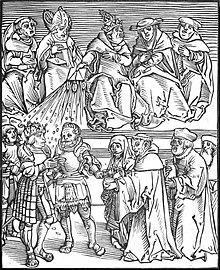| Christian eschatology |
|---|
| Christianity portal |

The Great Apostasy is a concept within Christianity to describe a perception that mainstream Christian Churches have fallen away from the original faith founded by Jesus and promulgated through his Twelve Apostles.[1]
A belief in a Great Apostasy has been characteristic of the Restorationist tradition of Christianity, which includes unrelated groups emerging after the Second Great Awakening, such as the Christadelphians, Swedenborgians, Latter Day Saints, Jehovah's Witnesses, and Iglesia ni Cristo.[2][3][4] These Restorationist groups hold that traditional Christianity, represented by Catholicism, Protestantism and Orthodoxy, has fallen into error and thus, the true faith needs to be restored.[1]
The term has been used to describe the perceived fallen state of traditional Christianity, especially the Catholic Church, sometimes claiming that it changed the doctrines of the early church and allowed traditional Greco-Roman culture (i.e., Greco-Roman mysteries, deities of solar monism such as Mithras and Sol Invictus, pagan festivals and Mithraic sun worship and idol worship) into the Church on its own perception of authority.[5] Because it made these changes using claims of tradition and not from scripture, the Church – in the opinion of those adhering to this concept – has fallen into apostasy.[6][7] A major thread of this perception is the suggestion that, to attract and convert people to Christianity, the Church in Rome incorporated pagan beliefs and practices within the Christian religion, mostly Graeco-Roman rituals, mysteries, and festivals.[8]
The term is derived from the Second Epistle to the Thessalonians, in which the Apostle Paul informs the Christians of Thessalonica that a great apostasy must occur before the return of Christ, when "the man of sin is revealed, the son of destruction" (chapter 2:1–12). The Catholic Church, Lutheran Church, Eastern and Oriental Orthodox Churches have interpreted this chapter as referring to a future falling-away, during the reign of the Antichrist at the end of time.[9]
- ^ Molloy, Michael (2017). The Christian Experience: An Introduction to Christianity. Bloomsbury Publishing. p. 366. ISBN 978-1-4725-8284-3.
Like other Restorationists, Russell held the theory of the Great Apostasy, the belief that Christianity had fallen away from its original purity. To the simple early message of Christianity, he believed, later teachers and political leaders had added unwarranted beliefs and practices.
- ^ Buck, Christopher (2009). Religious Myths and Visions of America: How Minority Faiths Redefined America's World Role. ABC-CLIO. p. 88. ISBN 978-0-313-35959-0.
- ^ Lewis, Paul W.; Mittelstadt, Martin William (2016). What's So Liberal about the Liberal Arts?: Integrated Approaches to Christian Formation. Wipf and Stock Publishers. ISBN 978-1-4982-3145-9.
The Second Great Awakening (1790–1840) spurred a renewed interest in primitive Christianity. What is known as the Restoration Movement of the nineteenth century gave birth to an array of groups: Mormons (The Latter Day Saint Movement), the Churches of Christ, Adventists, and Jehovah's Witnesses. Though these groups demonstrate a breathtaking diversity on the continuum of Christianity they share an intense restorationist impulse. Picasso and Stravinsky reflect a primitivism that came to the fore around the turn of the twentieth century that more broadly has been characterized as a "retreat from the industrialized world."
- ^ Discoveries, Amazing. "Sun Worship | Paganism and Catholicism | Buddhism, Hinduism and Catholicism". amazingdiscoveries.org. Archived from the original on 2023-06-04. Retrieved 2020-08-25.
- ^ Newcomb, Harvey (2003). Great Apostasy: Being an Account of the Origin, Rise and Progress of Corruption and Tryanny in the Church of Rome. Kessinger Publishing. pp. ix. ISBN 978-0766178847.[permanent dead link]
- ^ Talmage, James E. (1973). Jesus the Christ (40th ed.). LDS Church. pp. 745–757. OCLC 2012826.
- ^ Socrates, Church History, 5.22, in Schaff, Philip (July 13, 2005). "The Author's Views respecting the Celebration of Easter, Baptism, Fasting, Marriage, the Eucharist, and Other Ecclesiastical Rites". Socrates and Sozomenus Ecclesiastical Histories. Calvin College Christian Classics Ethereal Library. Retrieved 20 July 2018.
- ^ DeGarmo, Braxton (15 September 2019). Still Here!: Surviving the End Times. Christen Haus Publishing. p. 23. ISBN 978-1-943509-35-5.
Amillennialism has been the primary perspective of the church though most of history and still outside of the U.S., as well as in the orthodox (Catholic and Eastern Orthodox) and reform (Presbyterian and Lutheran) groups within the U.S.